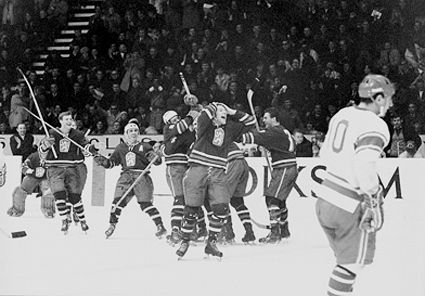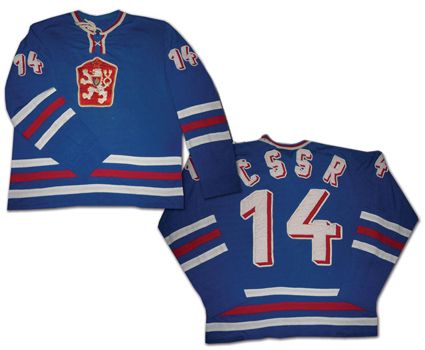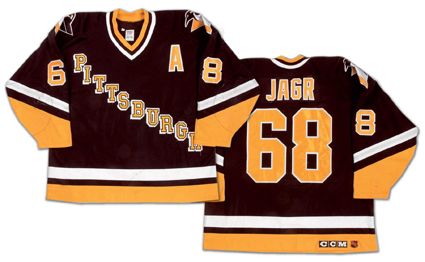Overcome by a vicarious sense of triumph, a huge and excited crowd swarmed into Prague’s Wenceslas Square. One happy hockey fan carried a poster that read BREZHNEV 3, DUBČEK 4. The crowd chanted, “We’ve beaten you this time!” Someone shouted, “The Russian coach will go to Siberia!”
Thursday, July 14, 2011
1969 Czechoslovakia Vaclav Nedomansky Jersey
July by the Numbers travels behind the Iron Curtain for jersey #14.
The Prague Spring began in early January of 1968 when Alexander Dubček came to power in communist Czechoslovakia, beginning in a period of liberalization in which Dubček attempted to grant greater freedom by loosening restrictions on the media, art, speech and travel. These reforms did not go over well with the Soviets, who eventually invaded Czechoslovakia and it's capital of Prague with approximately 750,000 troops from the Warsaw Pact (the Soviet Union, Bulgaria, East Germany, Hungary and Poland) on August 20, 1968 which resulted in 108 Czech and Slovak deaths and 500 injuries to primarily civilians. Despite being arrested and taken to Moscow, Dubček was allowed to remain in office and was returned to Prague a week later.
Dubček remained in his position until April of 1969 when he was forced to resign following the Czechoslovak Hockey Riots, which took place in response to the 1969 World Hockey Championships.
Originally scheduled to be held in Prauge, the 1969 World Championships were moved to Stockholm, Sweden due to the invasion and began on March 15th, when the Czechs defeated Canada by a resounding 6-1 score. Sweden beat Finland 6-3 and the Soviet Union destroyed the United States with a 17-2 pummeling also on day one which would prove vital later in the tourament. Entering the tournament the Soviet Union had won the last six World Championships as well as the last three out of four Olympic Games.
On March 21st, the Czechs and Soviets met in day six of the tournament with the Soviets at 4-0 with a 34-6 edge in goals scored up to that point, while the Czechoslovakians were 3-1 following a 2-0 loss to Sweden.
To the Soviet team this was just another hockey game, but not to the Czechs. With 70,000 Red Army soldiers still occupying their country, it was about much more than just hockey.
“We said to ourselves, even if we have to die on the ice, we have to beat them,” said team captain Jozef Golonka many years later. “We received hundreds of telegrams from fans back home when we arrived in Stockholm. Almost all of them said: ‘Beat the Soviets. You don’t have to beat anyone else. Just beat the Soviets.’”
Following a scoreless first period, defenseman Jan Suchý scored his fifth goal of the competition at the 13 minute mark of period two to put the Czechs on top. Josef Černý added a second goal at the seven minute mark of the third period while legendary goalkeeper Vladimir Dzurilla held the Soviets at bay for a 2-0 shutout, sending thousands of Czechoslovakians into the streets back in Prague in celebration.
The Czechs then wrapped up three more wins until they were matched up against the Soviets for the second time, as the tournament format was for each of the six teams to face the other five two times each. The Soviet Union meanwhile marched through their three subsequent games as expected, setting up the rematch with both teams now at 7-1.
Jiří Holík opened the scoring at 15 minutes to put the Czechs ahead 1-0 after one. Vaclav Nedomanský gave the Czechs a 2-0 lead in the first minute of the second, but Valeri Kharlamov responded for the Soviet Union two minutes later and Anatoli Firsov tied the game at the 13 minute mark.
Josef Horešovský delighted the Czech fans with a go-ahead goal at the nine minute mark of the third period before Jaroslav Holík sent them into rapture with another Czech score just two minutes later. Alexander Ragulin got one back for the Soviets with less than two minutes to play, but it was not enough as Czechoslovakia held on for a 4-3 win, becoming the first team to ever defeat the Soviet Union twice in a single IIHF tournament.
Once again, a reported half a million Czechoslovakians took to the streets across the country in what was first a celebration of their hockey team's victory, but, particularly in Prague, evolved into a protest against the Soviet military which had continued their occupation of Czechoslovakia since the previous August.
From Time Magazine April 11, 1969:
Those particular protests turned violent when not only Soviet military units were attacked and their vehicles burned, but the offices of the Soviet airline Aeroflot were ransacked.
The uprising was suppressed by the Czech military, which was now under control of hardliners from the Communist Party, and the events were used as a pretext to oust the remaining leaders of the Prague Spring from power, Dubček in particular.
Heading into the final two days of the tournament, Czechoslovakia led with an 8-1 record, while the Soviet Union, thanks to their two losses to the Czechs were 7-2 and Sweden was 6-2 after a pair of losses to the Soviet Union. Sweden climbed into a tie with the Soviets thanks to taking their turn pounding the winless United States 10-4.
On March 30th, the Czechs let the gold medal slip from their grasp following a 1-0 loss to Sweden while the Soviet Union made it a three way tie atop the standings at 8-2 thanks to their 4-2 win over Canada. Since the Czechs beat the Soviets twice who beat the Swedes twice who beat the Czechs twice, the medal placings were decided by goal differential, giving the Soviet Union the gold with a +36, the Swedes silver at +26 and the Czechs bronze at +20, which mattered little to the fans back at home following their joy at beating the country of their occupying forces not once, but twice. ”You sent us tanks, we send you goals” was the celebratory cry.
The events of the Prague Spring and subsequent invasion, as well as the fact his grandfather died in prison that year, are preserved by Jaromir Jagr's choice of #68 in remembrance.
Today's featured jersey is a 1969 Czechoslovakia Vaclav Nedomansky jersey as worn in the emotionally charged 1969 World Championships when Czechoslovakia defeated the Soviet Union twice, thrilling the Czechs back at home who were still under occupation.
While many would expect Czechoslovakia to wear red, they have in fact, worn blue off an on during their history, including periods of use in the 1930's, 40's and 50's as well as from 1965 to 1974 before a permanent change to red jerseys in 1975.
This striking jersey is an all-time classic, with the simplicity of the striping, lace up collar, heraldic main crest as well as the unique font for the numbers, which are then drop shadowed and outlined, a treatment which is also carried over to the CSSR lettering on the back, which is then radially arched, an early precursor to player names on the back, which did not become a regular part of NHL jerseys until the mid 1970's.
Bonus Jersey: Today's bonus jersey is a 1995-96 Pittsburgh Penguins Jaromir Jagr jersey which features Jagr's instantly recognizable #68 in memory of the Prague Spring.
In today's video section, scenes from the Warsaw Pact invasion of Czechoslovakia in August of 1968.
Here is a special treat, footage of Czechoslovakia beating the Soviet Union at the 1969 World Championships, showing footage from the game as well as the heroes welcome they received when they returned home.
Labels:
Czechoslovakia,
Jagr Jaromir,
Nedomanský Václav
Subscribe to:
Post Comments (Atom)

















I would like to add one interesting fact:
ReplyDeleteFew Czechoslovak players used duct tape to cover star on the chest of this jersey for the match with Soviets. The Czech(oslovak) national symbol used to be lion with a crown but communist regime (being under heavy Soviet influence) decided to change the crown to the star - hated symbol of Soviets and Red army.
You can actually see the duct tape in the second picture of this article: it is the black rectangular spot on the chest of the first player from the right.
Thank you so much for your interesting comment and that extra information, which we had never heard before. It is much appreciated!
ReplyDelete